

Better Learning Through Movement - Computer Science Teacher - Thoughts and Information from Alfred Thompson. And fun as well.
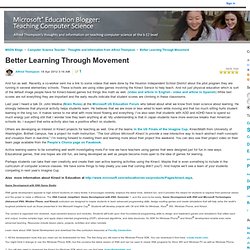
Recently a co-worker sent me a link to some videos that were done by the Houston Independent School District about the pilot program they are running in several elementary schools. These schools are using video games involving the Kinect Sensor to help teach. And not just physical education which is sort of the default image people have for Kinect-based games but things like math as well. (video and article in English - video and article in Spanish) While test scores are not everything they are important and the early results indicate that student scores are climbing in these classrooms. Last year I heard a talk Dr. Others are developing an interest in Kinect projects for teaching as well. How to Teach Computing across the Curriculum: Why not Logo?
April 13, 2012 at 8:55 am Because of my recent posts on teaching with Logo and the culture of older programming languages , I’ve been poking around the Logo sites.
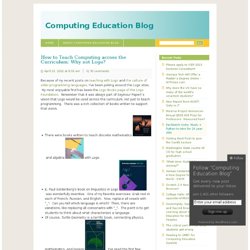
My most enjoyable find has been the Logo Books page of the Logo Foundation . Remember that it was always part of Seymour Papert’s vision that Logo would be used across the curriculum, not just to teach programming. There was a rich collection of books written to support that vision. Kids can't use computers... and this is why it should worry you - Coding 2 Learn. TL;DR?
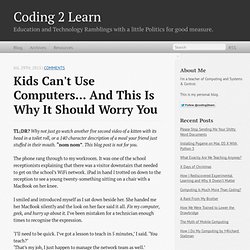
Why not just go watch another five second video of a kitten with its head in a toilet roll, or a 140 character description of a meal your friend just stuffed in their mouth. “nom nom”. This blog post is not for you.
New Visual Tool Teaches Kids How to Code at Home. Digital Tools Tynker.com As the conversation about education shifts towards helping students develop useful skills in life beyond the classroom, a new spotlight on computer coding has emerged.
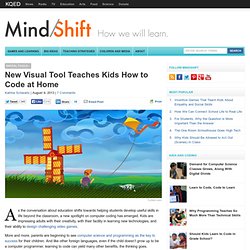
Cracking coding: Why schools should invest in computer programming. Released 26/07/2013 Curriculum changes that came into play last September saw children as young as eight learning how to program.
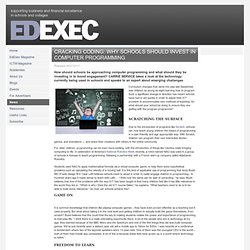
Computational Thinking - IAE-Pedia. Information Age Education (IAE) is an Oregon non-profit corporation created by David Moursund in July, 2007.

It works to improve the informal and formal education of people of all ages throughout the world. A number of people have contributed their time and expertise in developing the materials that are made available free in the various IAE publications. Click here to learn how you can help develop new IAE materials. Computers are incredibly fast, accurate, and stupid. Human beings are incredibly slow, inaccurate, and brilliant. Introduction The statement quoted above captures the essence of computational thinking. Here is a more recent description of computational thinking: Computational thinking is a way of solving problems, designing systems, and understanding human behavior that draws on concepts fundamental to computer science. Computer Science Teachers Association: The Good News about Computer Science. As is my usual practice, I have been mulling over what to write in my blog post for approximately the last month.
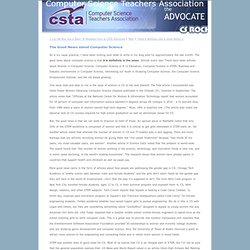
The good news about computer science is that it is definitely in the news. Almost every day! There have been articles about Women in Computer Science, Computer Science in K-12 Education, Computer Science in STEM, Business and Industry Involvement in Computer Science, Interesting our Youth in Studying Computer Science, the Computer Science Employment Outlook, and the list keeps growing.
Computing Projects for Girls. This is a big topic on my mind of late.

There is some discussion of this in the comments on my Boring Projects post and well as some responses via Twitter. Joanne Cohoon left a comment on the post suggesting health related projects like Body Mass Indicator (BMI) might appeal to girls. She added “helping people” via Twitter with a recommendation for the DotDiva website for ideas. It’s at not .com. I think that was a typo in the tweet. Blog Post #999: Research Questions in Computing Education. May 3, 2012 at 6:16 am The 999th blog post feels like a good point to think about where we’re going.
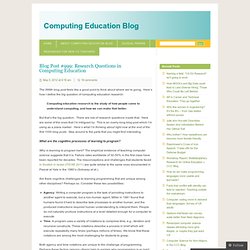
Here’s how I define the big question of computing education research: Computing education research is the study of how people come to understand computing, and how we can make that better. But that’s the big question. Using Hip-Hop to Teach Computer Science. Posted July 11, 2012 | Atlanta, GA Georgia Tech is welcoming 18 metro Atlanta high school students to campus this week, hosting a musical summer camp that is intended to have broad implications for the future of computer science education.
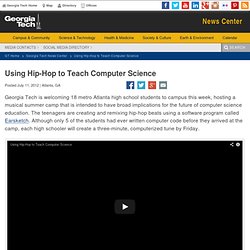
The teenagers are creating and remixing hip-hop beats using a software program called Earsketch. Although only 5 of the students had ever written computer code before they arrived at the camp, each high schooler will create a three-minute, computerized tune by Friday. Introducing Programming to Preschoolers. Kids and Coding Teaching Strategies Flickr: AngryJulieMonday By Heather Chaplin Since MIT’s Lifelong Kindergarten group released Scratch in 2007, kids ages 8 to 13 have built more than 2.2 million animations, games, music, videos and stories using the kid-friendly programming language. Scratch allows kids to snap together graphical blocks of instructions, like Lego bricks, to control sprites—the movable objects that perform actions.
Sprites can dance, sing, run and talk. 20 Tips to Successful Learning Programming. 20 Tips to success are as follows: 1. Initial capital is the motivation to learn programming. Young Programmers Podcast. Why all our kids should be taught how to code. What's missing from teaching computing in schools is a big vision. Photograph: Alamy A vigorous debate has begun – within government and elsewhere – about what should be done about information and communication technology (ICT) in the school curriculum.
Various bodies – the Royal Society, the Association for Learning Technology, Computing at School (a grassroots organisation of concerned teachers) and the British Computer Society, to name just four – have published reports and discussion documents aimed at ministers and the Department for Education. Teaching kids how to write computer programs, by Marshall Brain. By Marshall Brain Quick Intro - If you are looking for a quick and easy way to teach your kid a real programming language, without downloading anything or buying anything, try these Python tutorials.
Your kid will be writing and modifying code in just a few minutes. Marshall Brain's quick and easy Python tutorials. Is programming the new math? This past semester I taught a programming elective for seniors We used Python because it's already installed on all of the school computers and we have a resident Python expert who I could turn to for support.To be honest, I didn't have very much programming experience before the class began. I had taken a C class in grad school when I was too sick of math to care about my research, and that's the only formal programming I had done. This summer I taught myself some Python using this fantastic book by Michael Dawson, which teaches the basics through programming games.
By the end of the summer, I knew enough to plan the first couple of months of class. Nobody Wants to Learn How to Program. Jamie Tolentino: How to Get Your Kid Coding When You Don't Know How to Code Yourself. Teaching kids how to write computer programs, by Marshall Brain. Awesome Universe of Creative Coding, Explained in Five Minutes [Video] “What’s creative coding?” At last, we have a five-minute video that, in rapid-cut wonder, explains the answer to lay people – and can be a serious dose of inspirational adrenaline to people doing it. (If designers and artists had locker rooms, watching this before tackling that next Processing tutorial might be in order.) Cover the big three of open-source, free-software toolkits for artists – Processing, OpenFrameworks, and Cinder – and showing everything you can do with them (from big-screen video walls to generative fashion), the video has nearly all the bases covered. Learning to Code Isn't Enough.